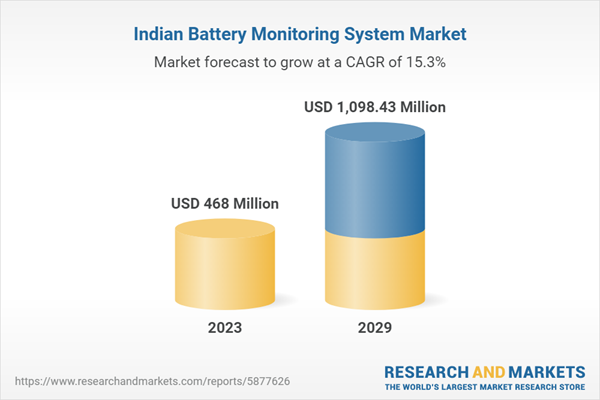Speak directly to the analyst to clarify any post sales queries you may have.
10% Free customizationThis report comes with 10% free customization, enabling you to add data that meets your specific business needs.
Battery monitoring systems are devices that interface directly with lead-acid and nickel-cadmium battery systems. They are used for collecting and transmitting battery performance data until battery life is exhausted. It also analyzes and monitors battery parameters 24/7, providing valuable data every second and generating reports to help prevent battery degradation and unplanned power outages.
Each battery is fitted with a monitoring sensor. Sensors measure the charging and discharging currents of individual battery cells. This data is sent to the surveillance system controller. Data is stored in the monitoring system controller and trended using battery monitoring software. The software converts the data into readable performance data. The controller alerts the user with an alarm alert via email and/or mobile SMS. The software allow users to access battery data quickly and easily for trend analysis, which is viewable on a PC. Identifying problems, performing predictive analytics, and generating simple, clear reports is easy with the help of battery monitoring software.
Rise in Demand for Battery Monitoring Systems is Fueling the Market Growth
Battery monitoring systems have become essential for every data center. Keeping data centers running is critical, and even a temporary outage can result in significant financial losses that might damage a company's reputation. More and more data centers are realizing that the risk of power outages can be mitigated by installing battery monitoring systems. Hence, there is an increasing demand for battery monitoring in data centers to keep the business running and in a safer place.The purpose of a real-time car battery monitoring system is to prevent discharging a car battery beyond the point at which the car can be restarted. This is a common problem that can leave people stuck and very uncomfortable. Also, discharging the battery will significantly shorten the life of the car battery. A real-time battery monitoring system (BMS) can monitor car battery and disconnect it from your car before it completely discharges. BMS prevents the user from draining the car's battery to the point where the engine cannot be started. After the BMS is activated, an indicator light helps users determine if the system is active. An override switch allows the user to turn his BMS on and off. This option allows one to access their car's battery immediately after enabling BMS.
Increasing adoption of electric vehicles is a major factor increasing the demand of the battery monitoring system market. The main factors that have led to the development of electric vehicles are the depletion of fossil fuels, increasing vehicle pollution. Additionally, the need for electric vehicles is driving up the cost of fuel used in internal combustion engines (ICs). Batteries play an important role when it comes to powering electric vehicles. High energy density, low emission rate, and long life are various advantages of batteries used as power sources for electric vehicles.
Market Segmentation
India Battery Monitoring System market is segmented into Component, Type, Battery Type, End-Users. Based on Component, the market is bifurcated into Hardware and Software. Based on Type, the market is bifurcated into Wired Battery Monitoring System and Wireless Battery Monitoring System. Based on Battery Type, the market is further bifurcated into Lithium-Ion Based Battery, Lead-Acid Battery, and Others. Based on End User, the market is further bifurcated into IT & Telecommunications, Energy, Automotive and Others.Market Players
Major market players in the India Battery Monitoring System market are Mitsubishi Electric Corporation, Fuji Electric Co., Ltd., Toshiba Corporation, Infineon Technologies AG, ON Semiconductor Corporation, STMicroelectronics International N.V., Texas Instruments Incorporated., Renesas Electronics Corporation, Vishay Intertechnology, Inc., NXP Semiconductors N.V.Report Scope
In this report, India Battery Monitoring System Market has been segmented into the following categories, in addition to the industry trends which have also been detailed below:India Battery Monitoring System Market, by Component:
- Hardware
- Software
India Battery Monitoring System Market, by Type:
- Wired Battery Monitoring System
- Wireless Battery Monitoring System
India Battery Monitoring System Market, by Battery Type:
- Lithium-Ion Based Battery
- Lead-Acid Battery
- Others
India Battery Monitoring System Market, by End-User Type:
- IT & Telecommunications
- Energy
- Automotive
- Others
India Battery Monitoring System Market, by Region:
- North India
- South India
- West India
- East India
Competitive Landscape
Company Profiles: Detailed analysis of the major companies present in the India Battery Monitoring System market.Available Customizations
The following customization options are available for the report:- Detailed analysis and profiling of additional market players.
This product will be delivered within 1-3 business days.
Table of Contents
Companies Mentioned
- Mitsubishi Electric Corporation
- Fuji Electric Co. Ltd.
- Toshiba Corporation
- Infineon Technologies AG
- ON Semiconductor Corporation
- STMicroelectronics International N.V.
- Texas Instruments Incorporated.
- Renesas Electronics Corporation
- Vishay Intertechnology, Inc.
- NXP Semiconductors N.V.
Table Information
| Report Attribute | Details |
|---|---|
| No. of Pages | 88 |
| Published | September 2023 |
| Forecast Period | 2023 - 2029 |
| Estimated Market Value ( USD | $ 468 Million |
| Forecasted Market Value ( USD | $ 1098.43 Million |
| Compound Annual Growth Rate | 15.2% |
| Regions Covered | India |
| No. of Companies Mentioned | 10 |









